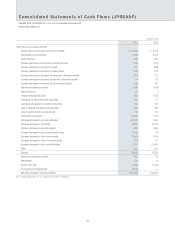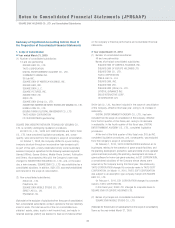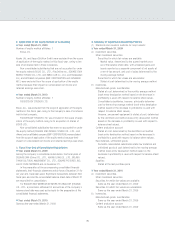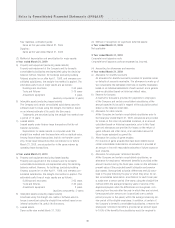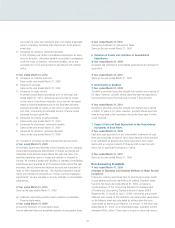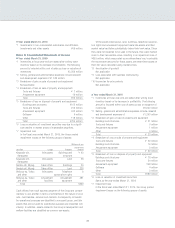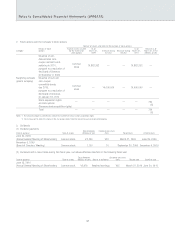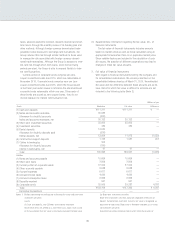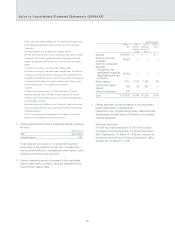Square Enix 2010 Annual Report Download - page 40
Download and view the complete annual report
Please find page 40 of the 2010 Square Enix annual report below. You can navigate through the pages in the report by either clicking on the pages listed below, or by using the keyword search tool below to find specific information within the annual report.
or income before income taxes and minority interests. The effects of
adopting the new standard to the segment information are noted in
the applicable section.
(Practical Solution on Unification of Accounting Policies Applied
to Foreign Subsidiaries for Consolidated Financial Statements)
Effective from the fiscal year ended March 31, 2009, the Company
has adopted the “Practical Solution on Unification of Accounting
Policies Applied to Foreign Subsidiaries for Consolidated Financial
Statements” (ASBJ Practical Issues Task Force No. 18, issued
on May 17, 2006) and made revisions required for consolidated
accounting. This change had an immaterial impact on operating
income, recurring income, and income before income taxes and
minority interests.
(Accounting Standard for Lease Transactions)
Finance lease transactions that do not transfer ownership had
previously been accounted for in a similar manner to the account-
ing treatment for ordinary operating lease transactions. However,
effective from the fiscal year ended March 31, 2009, the Company
adopted the “Accounting Standard for Lease Transactions” (ASBJ
Statement No. 13, originally issued by the First Subcommittee of
the Business Accounting Council on June 17, 1993, and revised
on March 30, 2007) and the “Guidance on Accounting Standard for
Lease Transactions” (ASBJ Guidance No. 16, originally issued by the
Law and Regulation Committee of the Japanese Institute of Certified
Public Accountants (JICPA) on January 18, 1994, and revised on
March 30, 2007) to account for such transactions in a manner
similar to the accounting treatment for ordinary sale and purchase
transactions. Regarding methods for depreciation of leased assets
under finance lease that do not transfer of ownership, depreciation
is computed under the straight-line method over the lease term with
no residual value. There was no impact on operating income, recur-
ring income, or income before income taxes and minority interests
as a result of this change. For finance lease transactions that do not
transfer ownership, and that commenced before the initial year of
the adoption of new accounting standards, the Company continues
to account for in the same manner as operating lease transactions.
■ Year ended March 31, 2010
(Application of Partial Amendments to Accounting Standard for
Retirement Benefits (Part 3))
Effective from this fiscal year, the Company has applied “Partial
Amendments to Accounting Standard for Retirement Benefits (Part 3),”
(ASBJ Statement No. 19, July 31, 2008).
This change had no material impact on operating income, recurring
income or income before income taxes and minority interests.
No retirement benefit obligation difference was recognized as a
result of the application of this accounting standard.
Reclassifications
■ Year ended March 31, 2009
(Consolidated Balance Sheets)
Accompanying the application of the “Cabinet Office Ordinance
Partially Amending the Regulations on the Terminology, Format and
Preparation of Financial Statements” (Cabinet Office Ordinance No. 50,
August 7, 2008), the item presented as “inventories” in the fiscal
year ended March 31, 2008 has been classified into “merchandise
and manufactured goods,” “work in progress,” and “raw materials
and supplies,” starting from the fiscal year ended March 31, 2009.
In the fiscal year ended March 31, 2008, “merchandise” and “fin-
ished goods,” “work in progress,” and “raw materials and supplies,”
that were presented as “inventory,” were ¥2,629 million, ¥639 mil-
lion, and ¥999 million, respectively.
(Consolidated Statements of Changes in Net Assets)
Starting from the fiscal year ended March 31, 2009, to conform
with the introduction of extensible business reporting language
(XBRL) to EDINET (Electronic Disclosure for Investors’ NETwork),
which aims to improve the comparability of financial statements,
“change in scope of consolidation” combines two separate items
presented in the fiscal year ended March 31, 2008. Those two
items were “change due to increase in consolidation,” which
amounted to ¥(63) million, and “increase in retained earnings due
to exclusion of subsidiaries from the scope of consolidation,” which
amounted to ¥731 million, in the fiscal year ended March 31, 2008.
In the fiscal year ended March 31, 2009, “increase in retained
earnings due to exclusion of subsidiaries from the scope of consoli-
dation” amounted to ¥16 million.
■ Year ended March 31, 2010
(Consolidated Balance Sheets)
Until the fiscal year ended March 31, 2009, “income taxes receiv-
able” was presented as part of “other” within current assets. From
the fiscal year ended March 31, 2010, “income taxes receivable” is
presented as a separate item as a result of an increase in
materiality.
In the fiscal year ended March 31, 2009, “income taxes receiv-
able” amounted to ¥1,422 million.
(Consolidated Statements of Income)
Until the fiscal year ended March 31, 2009, “gain on sale of
property and equipment” was presented as part of “other” within
extraordinary gain. From the fiscal year ended March 31, 2010,
“gain on sale of property and equipment” is presented as a separate
item due to composition exceeding 10 percent of total extraordinary gain.
In the fiscal year ended March 31, 2009, “gain on sale of prop-
erty and equipment” amounted to ¥4 million.
Notes to Consolidated Balance Sheets
■ Year ended March 31, 2009
*1 Investments in non-consolidated subsidiaries and affiliates:
Investments and other assets ¥127 million
Notes to Consolidated Financial Statements (JPNGAAP)
38






